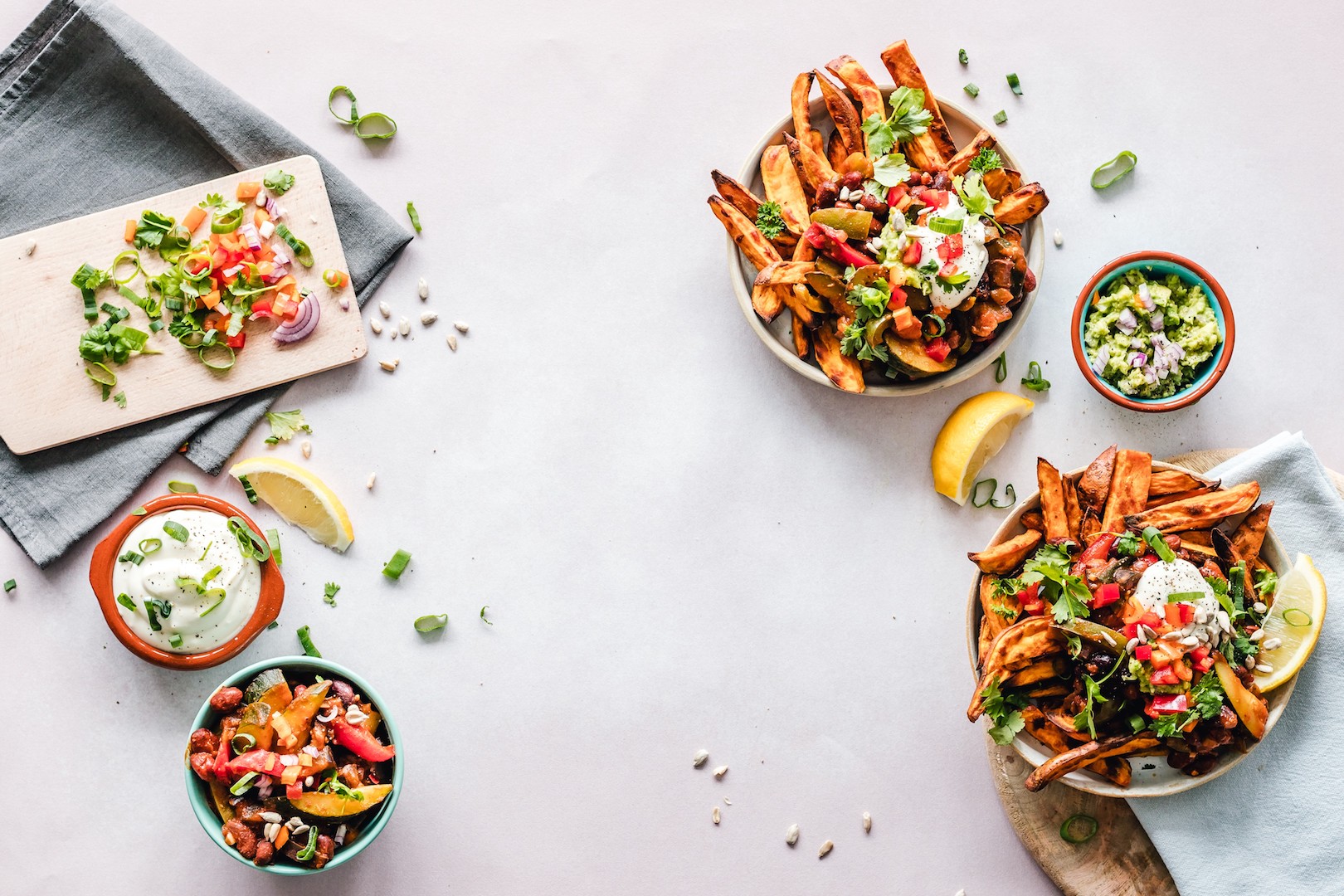There is no one-size-fits-all when it comes to nutrition. In fact, part of the beauty of human physiology is our body’s inherent ability to thrive on variety in the foods we consume!
If you’re reading anything that says we’ve found a clear winner — aka one specific diet to suit the needs of every human being on earth — then I would advise you to quickly click away. Realistically speaking, evidence-based diets are not designed to provide you with a shopping list for the grocery store; they’re designed to provide you with the themesof one.
Across the board, all research tends to point towards these common themes when it comes to following a healthy diet: namely one that is low in saturated fat, low in trans fat, low in processed foods, and high in plant-based foods (1–5).
But how does that help you figure out what to eat exactly? Surely there must be some sort of a hierarchy for ranking even the “healthiest” of foods? Are all plants really created equal?
Yes and no.
All too often, we see foods being defined as “healthy” — not based on what they do contain — but based exclusively on what it is they don’t (that is, low-sugar, low-sodium, fat-free, etc.)(6). You don’t have to be a qualified nutritionist to understand why this might present a bigger problem for public health.
To resolve this confusion, recent studies have tried to come up with a more clear-cut definition for what it means to be a “powerhouse food.” Some research suggests basing this definition on food’s nutrient and phytochemical constituents, while others recommend highlighting the foods most associated with a lowered risk of chronic disease (7–9).
Come to find out, just like diet and nutrition — there is no one definition of ‘powerhouse’ that fits all.
Featuring a combination of research studies that range in their focus on nutrient density (aka a nutrient-per-calorie score) and disease-fighting superfoods, to the fruits and vegetables scoring highest in the 17 key compounds outlined by the Food and Agriculture Organization of the United Nations and Institute of Medicine, this article, however, is designed to provide you with a quality starting point when it comes to knowing how to fuel your body with the right kinds of foods! I hope you enjoy it.
“When we escape ‘nutritionism’, reducing foods down to their calorie, protein, fat or carb content, we can focus on what matters most! The quality of food — the package that our calories are coming in.”
— Simon J Hill, Author of the Proof Is In The Plants
10 Of The Best ‘Nutritional Powerhouse’ Foods That You Should Be Consuming On The Reg:
1. Açaí
A rather famous paper developed by 500 researchers in 50 different countries, known as The 2010 Global Burden of Disease Study, is currently one of the largest conclusive analyses of risk factors for death and disease we have — to date.
In this paper, researchers were not only identified dietas the leading cause of both death and disability across the globe, but they were also able to specifically pinpoint the criterium of not eating enough berriesas that with the greatest overall success in predicting future disease (10).
So what’s the big secret with berries? Well, what actually makes berries so special has everything to do with their bright colour! In fact, on the Oxygen Radical Absorbance Capacity Index (ORAC), berries come second only to spices (another colourful food) in terms of their “total antioxidant capacity” within the body.
In the number one place on the list? Açaí berries — with a crazy high score of 102700! If you ask me, that’s a whole lot of antioxidant punch provided by one small palm-tree berry, and not to mention the excellent source of omegas they provide, in addition!
2. Avocado
Interestingly enough, avocados don’t even come close to being one of the foods with the highest antioxidant content — but they’re considered an impressive powerhouse of nutrients for other reasons…
Although there are inevitable merits to eating avocado by itself (make sure you’re getting that rich dark green flesh just under the skin while you’re at it), the optimal way to consume this fruit is actually by pairing it with other vegetables (11).
Sweet potatoes, carrots, and greens, for example, are extremely rich in a fat-soluble phytonutrient referred to as carotenoids — but because these veggies don’t contain any fats, healthful carotenoids, like beta-carotene, largely pass through the body unabsorbed.
Fascinatingly, research shows that the process as simple as eating some avocado on top of your salsa may actually triplethe amount of fat-soluble nutrients that make it into the bloodstream. Similarly, just 3 grams or one large spoonful of avocado in an entire hot meal may be sufficient to boost nutrient absorption substantially (12).
In addition, unlike the saturated fat found and meat, dairy, and eggs that leads to insulin resistance, oleate — the monounsaturated fat found mostly in nuts, olives, and avocados — may actually protect against saturated fats’ detrimental effects, making avocados a true powerhouse of protective properties (13).
3. Beetroot & Beet Greens
In a study measuring the fruits and vegetables most associated with reduced risks for cardiovascular disease, neurodegenerative diseases, and cancer, it was found that leafy greens scored predominantly in the top half of the distribution (14).
One particular type of leafy green — the (ironically) purple-stemmed greens of beetroot — has been linked to an impressive range of health effects within the body along with the body of the beet itself.
Beetroot is mostly famous for its bright pigmentation (watch out because it stains!) and high dietary source of nitrates. Nitrates not only help deliver oxygenated blood to your muscles, but they also encourage your body to use energy more efficiently under physical stress such as exercise. One study found that a single shot of beet juice allowed free-divers to hold their breathe for half a minute longer than usual, while another found that only a few bites of beetroot enabled cyclists to perform at a normal intensity while using up to 19% less oxygen (15, 16).
By eating both the beetroot and the beet greens, you provide your body will a highly concentrated dose of essential nutrients, from fiber and magnesium for digestion and nerve function to vitamin C and zinc for metabolic function and immunity!
4. Brazil Nuts
Did you know that eating a single Brazil nut per day provides you with 100% of the daily recommended intake of the essential nutrient selenium? Actually, so much so — 998% of the RDI to be precise — that eating more than only a few Brazil nuts in one day can result in harmful levels of the powerful mineral within the body (17).
So, so long as you don’t go nuts on the Brazil nuts, research shows that individuals who consume nuts regularly not only experience a reduced risk of chronic diseases such as heart disease and diabetes but also show improved blood sugar levels, a reduction in free-radicals, and a lowering of LDL cholesterol (aka the bad stuff)(18).
What’s more, despite their naturally high-fat content, studies have shown that daily consumption of nuts is not actually linked to any form of weight gain, with results indicating an association between nut consumption, a slimmer waistline, and a lower risk of obesity (19).
5. Cacao
You know it’s a good list when chocolate makes the cut!
Low and behold — dark chocolate, cocoa, and cacao (all just differently processed derivatives of the cacao bean) all score remarkably high in antioxidants, as well as vitamins and minerals such as iron, magnesium, manganese, and copper, too (20).
Research shows that people who consumed healthy forms of chocolate more than 5 times per week had a 57% lower risk of heart disease, while other studies suggest that the flavonoids found in cacao might help to increase insulin sensitivity and protect against diabetes (21, 22).
If you’re not sure which form of chocolate is best, consider that while gram-per-gram cacao may pack a more powerful nutritious punch, cocoa powder and dark chocolates made from 70% cocoa and above might be more affordable options in the long run!
6. Dulse
Sea vegetables, like seaweed and dulse, actually comprise around 30% of the total edible vegetables on earth — in many cases offering nutrients, you’d be hard-pressed to find an equivalent to amongst the vegetables we grow on land.
A population study on women with and without breast cancer found that individuals consuming a single sheet of nori seaweed per day may cut their risk of developing or re-developing breast cancer by more than half (23).
It is thought that seaweed and sea vegetables, in general, may help to moderate the levels of estrogen processed in the metabolism, thereby lowering the risk of associated cancers and disease.
So besides being a super source of numerous polysaccharides, thyroid-supporting iodine, and polyphenol defense-compounds, even just a small, teaspoon-sized sprinkling of dulse on your food from time to time is sure to help you fight disease from the inside out (24).
7. Flaxseeds
An incredible study conducted in 2013 found that ground flaxseed provided one of the most strong anti-hypertensive effects to ever be achieved by a single food item.
Indeed, results found that only a few tablespoons of the ground flax (added to a smoothie, or incorporated into baked goods, perhaps) caused a lowering of blood pressure and the risk of stroke 2–3 times stronger than the effect of introducing participants to daily aerobic endurance exercises (6).
Although flax probably shouldn’t replace your exercise regimen entirely, the powerhouse of nutrients contained by this wonderful seed is certainly worth keeping in mind when planning your daily meals!
Pro tip: A ratio of 2 tablespoons of water and 1 tablespoon of ground flax seeds left to soak for 5–10 minutes in the fridge can act as a cholesterol-free (and cholesterol-lowering) substitution in just about any baking recipe that calls for eggs!
8. Garlic
Aside from being arguably one of the most delicious ingredients on the planet, garlic is an incredible source of vitamins such as C, B1, B6, as well as cancer-fighting sulfur compounds like allicin!
Linked to a lowering of LDL cholesterol and an increase in levels of healthy HDL cholesterol, the allicin in garlic is known for reducing the risk of heart disease in addition to inhibiting the growth of cancer cells, and particularly those concerning the digestive tract such as throat, stomach, and colon cancer (25, 26).
Medicinally speaking, raw garlic has been used both internally and topically throughout history as a substance presenting powerful anti-bacterial and anti-fungal properties — although I’m not necessarily going to suggest you eat it this way.
9. Kale
When it comes to eating your vegetables — just know that cruciferous is king!
This is because there’s an active ingredient in cruciferous vegetables that makes this category of plant food a particularly nutritional powerhouse when it comes to fending off disease. This compound — something called sulforaphane — is responsible for a range of functions within the body, such as protecting our brain, preserving our eyesight, shielding us from hazardous products of our environment, as well as treating and preventing the growth of various cancers (27).
For more information about the science behind sulforaphane (trust me when I tell you it’s a little hard to believe), check out my article, “What Chopping Your Vegetables Has To Do With Fighting Cancer.”
Loaded with vitamins, minerals, fiber, antioxidants, and a whole lot of sulforaphane, kale is one of the healthiest greens you can consume. A single 100-gram portion contains roughly 1000% of your vitamin K1, 300% of your vitamin A, and 200% of your vitamin C in accordance with the RDI — and all for under 60 calories.
10. Lentils
In a research study comparing the total antioxidant content of 9 different types of legume, it was lentils established as the number one bean across the board — especially when it came to their ability to scavenge up free radicals within the body (28).
Free radicals are the molecules responsible for mutations within the body that can wreak havoc on lipids, proteins, and DNA, raising the likelihood of disease and cancer in the process. Free radicals are largely unavoidable as they result from the natural process of cellular metabolism but can be protected against through the consumption of anything with properties that include ‘anti-oxidant and ‘detoxifying.’
Research on the diet of individuals from populations all over the globe has provided significant evidence for beans (otherwise referred to as legumes) as being one of the single “most important predictors of survival in older people” (29).
Text References:
- P J Tuso, M H Ismail, B P Ha, C Bartolotto. Nutritional update for physicians: Plant-based diets. Perm J 2013 17(2):61–66.
- Kaiser Permanente. The Plant-Based Diet a healthier way to eat. Kaiser Permanente 1–20.
- A Drewnowski, J Hill, B Wansink, R Murray, C Diekman. Achieve Better Health With Nutrient-Rich Foods. Nutrition Today: January/February 2012 — Volume 47 — Issue 1 — p 23–29.
- D C Willcox, B J Willcox, H Todoriki, M Suzuki. The Okinawan diet: health implications of a low-calorie, nutrient-dense, antioxidant-rich dietary pattern low in glycemic load. J Am Coll Nutr. 2009 Aug;28.
- Williams KA. Introduction to the “A plant-based diet and cardiovascular disease” special issue. J Geriatr Cardiol. 2017;14(5):316.
- Drewnowski A. Concept of a nutritious food: toward a nutrient density score. Am J Clin Nutr. 2005 Oct;82(4):721–32.
- Nanney MS, Haire-Joshu D, Hessler K, Brownson RC. Rationale for a consistent “powerhouse” approach to vegetable and fruit messages. J Am Diet Assoc. 2004 Mar;104(3):352–6
- Darmon N, Darmon M, Maillot M, Drewnowski A. A nutrient density standard for vegetables and fruits: nutrients per calorie and nutrients per unit cost. J Am Diet Assoc
- Di Noia J. Defining powerhouse fruits and vegetables: a nutrient density approach. Prev Chronic Dis. 2014 Jun 5;11:E95. doi: 10.5888/pcd11.130390. PMID: 24901795; PMCID: PMC4049200.
- The Global Burden of Disease Study 2010 (GBD 2010)
- Ameer K. Avocado as a major dietary source of antioxidants and its preventive role in neurodegenerative diseases. Adv Neurobiol. 2016;12:337–354.
- Unlu NZ, Bohn T, Clinton SK, Schwartz SJ. Carotenoid absorption from salad and salsa by humans is enhanced by the addition of avocado or avocado oil. J Nutr. 2005;135(3):431–436.
- Alvizouri-Muñoz M, Carranza-Madrigal J, Herrera-Abarca JE, Chávez-Carbajal F, Amezcua-Gastelum JL. Effects of avocado as a source of monounsaturated fatty acids on plasma lipid levels. Arch Med Res. 1992 Winter;23(4):163–7.
- Di Noia J. Defining Powerhouse Fruits and Vegetables: A Nutrient Density Approach. Prev Chronic Dis 2014;11:130390.
- Patrician, A. and Schagatay, E. (2017), Dietary nitrate enhances arterial oxygen saturation after dynamic apnea. Scand J Med Sci Sports, 27: 622–626.
- Thompson C, Wylie LJ, Fulford J, et al. Dietary nitrate improves sprint performance and cognitive function during prolonged intermittent exercise. Eur J Appl Physiol. 2015;115(9):1825–34.
- Cardoso BR, Duarte GBS, Reis BZ, Cozzolino SMF. Brazil nuts: Nutritional composition, health benefits, and safety aspects. Food Res Int. 2017 Oct;100(Pt 2):9–18.
- Y. Bao, J. Han, F. B. Hu, E. L. Giovannucci, M. J. Stampfer, W. C. Willett, C. S. Fuchs. Association of nut consumption with total and cause-specific mortality. N. Engl. J. Med. 2013 369(21):2001–2011.
- V. Vadivel, C. N. Kunyanga, H. K. Biesalski. Health benefits of nut consumption with special reference to body weight control. Nutrition 2012 28(11–12):1089–1097.
- Carlsen MH, Halvorsen BL, Holte K, et al. The total antioxidant content of more than 3100 foods, beverages, spices, herbs, and supplements used worldwide. Nutr J. 2010;9:3.
- Djoussé L, Hopkins PN, North KE, Pankow JS, Arnett DK, Ellison RC. Chocolate consumption is inversely associated with prevalent coronary heart disease: the National Heart, Lung, and Blood Institute Family Heart Study. Clin Nutr. 2011 Apr;30(2):182–7.
- Katz, D. L., Doughty, K., & Ali, A. (2011). Cocoa and chocolate in human health and disease. Antioxidants & redox signaling, 15(10), 2779–2811.
- H. Funahashi, T. Imai, T. Mase, M. Sekiya, K. Yokoi, H. Hayashi, A. Shibata, T. Hayashi, M. Nishikawa, N. Suda, Y. Hibi, Y. Mizuno, K. Tsukamura, A. Hayakawa, S. Tanuma. Seaweed prevents breast cancer? Jpn. J. Cancer Res. 2001 92(5):483–487.
- Ku CS, Yang Y, Park Y, Lee J. Health benefits of blue-green algae: prevention of cardiovascular disease and nonalcoholic fatty liver disease. J Med Food. 2013 Feb;16(2):103–11.
- Sobenin IA, Andrianova IV, Demidova ON, Gorchakova T, Orekhov AN. Lipid-lowering effects of time-released garlic powder tablets in double-blinded placebo-controlled randomized study. J Atheroscler Thromb. 2008 Dec;15(6):334–8
- Fleischauer AT, Arab L. Garlic and cancer: a critical review of the epidemiologic literature. J Nutr. 2001 Mar;131(3s):1032S-40S.
- Li Y, Zhang T, Korkaya H, Liu S, Lee HF, Newman B, Yu Y, Clouthier SG, Schwartz SJ, Wicha MS, Sun D. Sulforaphane, a Dietary Component of Broccoli/Broccoli Sprouts, Inhibits Breast Cancer Stem Cells. Clin Cancer Res. 2010 May 1;16(9):2580–90.
- Xu BJ, Yuan SH, Chang SK. Comparative studies on the antioxidant activities of nine common food legumes against copper-induced human low-density lipoprotein oxidation in vitro. J Food Sci. 2007;72(7):S522–7.
- I. Darmadi-Blackberry, M. Wahlqvist, A. Kouris-Blazos, et al. Legumes: the most important dietary predictor of survival in older people of different ethnicities. Asia Pac J Clin Nutr. 2004;13(2):217–20.





